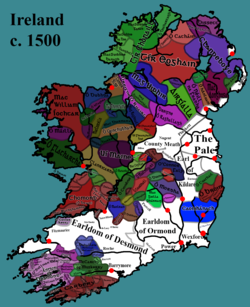
The Gaelic nobility of Ireland is one of three groups of Irish nobility, along with those nobles descended from the Hiberno-Normans and those granted titles of nobility in the Peerage of Ireland.

The Gaelic nobility of Ireland is one of three groups of Irish nobility, along with those nobles descended from the Hiberno-Normans and those granted titles of nobility in the Peerage of Ireland.
By the time of the Treaty of Limerick, almost all Gaelic nobles had lost any semblance of real power in their (former) domains. Historical titles have no legal status in the Republic of Ireland, which unlike the neighbouring United Kingdom (including Northern Ireland), does not confer titles of nobility under its constitution. [1]
From 1943 until 2003, some of the modern representatives of the Gaelic nobility obtained a courtesy recognition as Chiefs of the Name from the Irish government. The practice ended in 2003 following certain scandals (including a 'hoax' associated with Terence Francis MacCarthy) and based on concerns that it was unconstitutional. [2]



Clann territories were under the rule and control of a Chief, who was elected by a system called tanistry; voted by patrilineal descendants (within three generations) of the preceding Chief. The designation as Chief was also referred to as a King (Ri), Lord (Tiarna), or Captain of his countries, all of which were roughly equivalent prior to the collapse of the Gaelic order. The concept of a hereditary "title" originated with the adoption of English law, the policy of surrender and regrant and the collapse of the Gaelic order during the period from approximately 1585–1610. Because all new chiefs had to come from the same patrilineal lineage, each family developed a long history of ruling within an area, which gave rise to the concept of Gaelic nobility. However, ruling titles did not necessarily pass from father to son; rather it was by election from within the patrilineal kindred and bloodshed, given the absence of criminal penalties for the death of an opponent.
Flatha (princes) and also descendants in the male line, however distant in some cases, from at least one historical grade of Rí , a Rí túaithe (usually a local petty king), a Ruiri (overking or regional king), or a greater Rí ruirech (king of overkings, also called a provincial king or Rí cóicid) are considered Gaelic nobility. A number of rí ruirech also became Ard Rí and their surviving princely descendants remain claimants to the long vacant, so-called High Kingship. [3] A modern Gaelic noble may be styled a self-proclaimed flaith (prince) or tiarna (lord, count/earl). See also White Rod.
The ancient Gaelic families are divided by ancestry, sept, and by geography.
Other O'Neills did not apply for recognition. The most notable[ how? ] of these is the Prince of the Fews, Don Carlos O'Neill, 12th Marquis of Granja. There is a dispute between him and the Prince of Clanaboy over who is the "senior", with the matter appearing unresolvable. [15] However, more recently O'Neill of Clanaboy may[ how? ] have gotten the upper hand in the dispute. [16]
The O'Neills of the Fews are a 15th-century branch of the Tyrone or Ó Néill Mór line, whereas the O'Neills of Clanaboy are a High Medieval line. Hence the matter is academic, both being somewhat distant from the last sovereigns of Tyrone in Ulster (to 1607), whose plentiful descendants eventually fell into comparative obscurity. [15] Today they are known as the McShane-O'Neills, or the anglicised version — Johnson.[ citation needed ]
The chosen and recognised heir apparent of the Chief of the Name, Fr. Hugh O'Donel, O.F.M., is Don Hugo O'Donnell, 7th Duke of Tetuan. [17] Other members of the family have disputed this, most notably Fr. Hugh's sister, Nuala Ní Dhomhnaill, who has even on television and radio disputed the exclusion from the succession process of potential female and female line claimants, but the head of the genealogically senior line has been firm in his choice of his distant cousin the Duke of Tetuan. [18]
One of the more recent claimants to the title of MacCarthy Mór (Prince of Desmond) was Liam Trant MacCarthy (Mór). Trant MacCarthy has reportedly asserted descent from Tadhg na Mainistreach Mac Carthaigh Mór, King of Desmond (died 1426), and membership of the Srugrena sept. [19]
There remain other Gaelic nobles who are not of the "senior" lines, but whose descent is recognised in Europe and a number of whom also hold Continental titles.